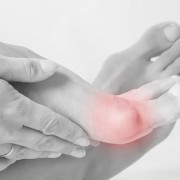How to deal with bunions
The common foot deformities can be successfully treated through simple footwear modifications or surgical procedure

Many are probably familiar with the unnatural shape of a bunion - one of the most common foot deformities in both men and women. The condition boils down to a swelling at the base of the big toe, which thus pushes to the next toe and forces the joint to stick out.
“In some cases bunions don’t cause any pain, so footwear modifications are usually effective in easing the deformity,” Dr Sean Ng, an orthopaedic surgeon at Gleneagles Hospital, told Global Health and Travel.
Most bunions, from 80 to 90 percent, are due to genetic factors inherited from parents; the remaining cases are caused by the regular use of tight shoes and high heels. Hence, bunions can rarely be prevented but people can slow down the progression of the swelling by wearing shoes that are not too high or pointy.
“However, when bunions are painful or there are other associated deformities such as over-riding second toe and clawed toes surgery is required to correct the problem,” said Dr Ng.
The best surgical option
The appropriate kind of surgery depends on the nature of the problem. Mild to moderate bunions can be treated best by percutaneous minimally invasive surgery, also known as keyhole surgery. For the rest of them, traditional open surgery is the treatment of choice.
“Many patients opt for regular open surgery, which is offered by every orthopaedic surgeon, as they are unaware of the keyhole option,” according to Dr Ng.
He added that minimally invasive surgery offers several benefits in terms of recovery and cosmetic outcome compared to open surgery.
The minimally invasive operation is fast, lasting from 30 minutes to one hour, and involves multiple small cuts ranging from a couple of millimetres to one centimetres. As a result, the wound heals very well and doesn’t produce a visible scar but a few small dots. By contrast, open surgery leaves a scar measuring from eight to ten centimetres.
In addition, minimally invasive surgery decreases the pain as well as the risk of infection and bleeding. Patients can choose general anaesthesia, spinal anaesthesia or ankle block, which only numbs the tissues below the ankle.
Patients undergoing keyhole surgery are able to walk the day after the operation by using special shoes and they don’t need any cast or clutch. Stitches are usually removed 10 to 14 days after surgery. While the healing process for the bone takes about six to eight weeks.
Once the bone heals, patients need to do physiotherapy to regain mobility and walk properly again. The overall healing time takes up from three to four months.
Patients are required to follow up once every week during the first three weeks post-operation. After that, one check-up every three weeks is enough, said Dr Ng.
“Post-op strapping of the foot is just as important as surgery,” he added. “The first 3 weeks are crucial as straps need to be changed every week to get the best [bone] alignment for recovery.”
 Dr Sean Ng is an orthopaedic surgeon at Gleneagles Hospital in Singapore. Dr Ng’s clinical interests are in percutaneous and minimally invasive foot and ankle surgery, and also arthritis, trauma and sports conditions. He also performs minimally invasive surgery for other parts of the feet such as deformities of other toes, achilles tendon, deformities in the heel and ankle surgery for runners or dancers.
Dr Sean Ng is an orthopaedic surgeon at Gleneagles Hospital in Singapore. Dr Ng’s clinical interests are in percutaneous and minimally invasive foot and ankle surgery, and also arthritis, trauma and sports conditions. He also performs minimally invasive surgery for other parts of the feet such as deformities of other toes, achilles tendon, deformities in the heel and ankle surgery for runners or dancers.
Gleneagles Hospital Singapore
6A Napier Road, Singapore 258500
Tel: (+65) 6735 5000
www.gleneagles.com.sg
Ardmore Orthopaedic Clinic
6 Napier Road
#07-07 Gleneagles Medical Centre
Singapore 258499
Tel: (+65) 6475 7177
Related Articles
When should I see a doctor for hip pain?
Dr Andrew Dutton shares what to expect when seeing the doctor for hip pain
Read moreWhat if your child has joint pain?
Arthritis can significantly affect the life of young children if it is not treated early, according to Dr Cham Weng Tarng from Sunway Medical Centre
Read moreWhat causes back pain?
Dr Benjamin Tow discusses the most common causes of acute and chronic back pain
Read moreLatest Articles
Medical Care
Clearing the Fog: Dispelling Common Diabetes Myths in Singapore
Uncover the truths and myths about diabetes with insights from Harmony Thyroid, Endocrinology and Diabetes Centre. Learn about prevention, diagnosis, and management strategies for diabetes in Singapore. Get expert guidance from Senior Consultant Endocrinologist Dr. Vikram Sonawane to navigate your diabetes journey effectively.
Read moreMedical Care
Achieving Swift Recovery: Enhanced Recovery (ERAS) Direct Anterior Approach Total Hip Replacement
Consider total hip replacement with Alps Orthopaedic Centre's ERAS Direct Anterior Approach for faster recovery and reduced hospital stays. Learn about Dr. Jerry Chen's expertise in Singapore.
Read moreMedical Care
Enhanced Recovery (ERAS) Total Knee Replacement
Discover how Alps Orthopaedic Centre's Enhanced Recovery After Surgery (ERAS) approach transforms total knee replacement into a day surgery, offering faster recovery, less pain, and reduced hospital bills. Learn about Dr. Jerry Chen's expertise and schedule your appointment in Singapore.
Read more